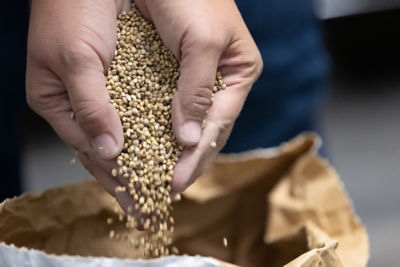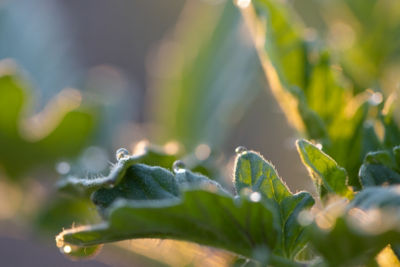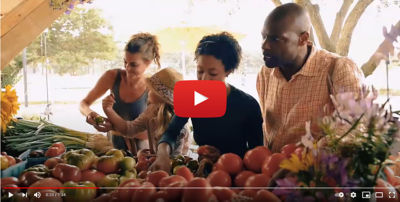Click here to download a PDF version of this spotlight.
» Conventional and conservation tillage practices are used in vegetable crop production systems.
» Conservation tillage practices can help mitigate some problems that result from long-term use of conventional tillage.
» Some vegetable crops may perform well when using reduced-till practices but others may not.
Tillage is used in vegetable production to loosen compacted soil, add organic matter or integrate crop residue, incorporate fertilizers, and prepare the seedbeds for planting. Seedbed preparation includes breaking up soil clods to create a fine uniform texture that helps facilitate uniform soil moisture, planting depths, seedling emergence, and root growth. Tillage also helps manage weeds and plant diseases.1,2 In conventional tillage systems, soil is turned over and soil aggregates are broken up using equipment such as moldboardplows, chisel plows, field cultivators, disk cultivators, and rototillers (Figure 1). Often multiple tillage passes are used to create the finely textured seedbed required for adequate stand establishment, especially for smallseeded vegetable crops such as lettuce, onions, and carrots.1,2,3 Finely textured seedbeds are also needed to create raised beds in plasticulture systems that allow for good soil-to-plastic contact needed to help maximize early-season soil heating (Figure 2).
 Figure 1. Field disked and plowed to prepare for onion planting. Howard F. Schwartz, Colorado State University, Bugwood.org
Figure 1. Field disked and plowed to prepare for onion planting. Howard F. Schwartz, Colorado State University, Bugwood.org
CONSERVATION TILLAGE
Repeated, intensive tillage can lead to problems with soil erosion, loss of nutrients, and the development of soil compaction layers.2,4 Studies have shown that reducing soil tillage can increase soil aggregate stability and water infiltration, reduce soil compaction and soil erosion, and enhance the biological activity within the soil that can help facilitate nutrient cycling and disease suppression.1,2,4
One way to help avoid some of the detrimental effects of conventional tillage is to use a form of conservation (or reduced) tillage when possible. With conservation tillage, at least 30% of the residue from the previous crop (or cover crop) remains on the soil surface. These practices are usually less intense and more shallow to minimize soil disturbance.4,5 Conservation tillage can help reduce soil erosion, increase soil organic matter content, conserve water, reduce nutrient runoff, and maintain a diverse and active rhizosphere
 Figure 2. (A) Finely tilled raised beds planted to lettuce. (B) Plastic mulch covering raised beds. Gerald Holmes, Strawberry Center, Cal Poly San Luis Obispo, Bugwood.org.
Figure 2. (A) Finely tilled raised beds planted to lettuce. (B) Plastic mulch covering raised beds. Gerald Holmes, Strawberry Center, Cal Poly San Luis Obispo, Bugwood.org.
microbiome. Conservation tillage can work well with largeseeded, fast-growing crops, such as cucurbits, or with transplanted crops, such as tomatoes. However, it is usually difficult to obtain adequate stand establishment when directly seeding small-seeded crops, such as onion, carrots, and lettuce, into a reduced tillage seedbed.5
CONSERVATION TILLAGE METHODS
There are several methods of conservation tillage that vary in the amount of crop residue left on the soil surface and the amount of soil disturbance.4,5
● No-till: all plant residue is left on the soil surface, and the soil is not disturbed other than by planting seeds or transplants (Figure 3).
 Figure 3. No-till production of tomatoes. Gerald Holmes, Strawberry Center, Cal Poly San Luis Obispo, Bugwood.org.
Figure 3. No-till production of tomatoes. Gerald Holmes, Strawberry Center, Cal Poly San Luis Obispo, Bugwood.org.
● Ridge-till: a soil ridge is built through cultivation, the top of the ridge is scraped off, and the seed is sown on the top of the ridge. Crop residue is moved to the area between the ridges and left on the soil surface.
● Strip-till: a narrow strip of soil is tilled for each row, and the areas between the strips are left untilled with the crop residue remaining on the surface. Soil disturbance is limited to the crop planting zone. The soil structure in the areas between the strips is left undisturbed, helping to reduce soil erosion. The soil in the strip area can be tilled to prepare a seedbed suitable for many vegetable crops.
● Permanent beds: suitable for small, diversified farms, fields can be divided into permanent beds between defined traffic areas. No equipment or foot traffic occurs in the permanent beds to minimize soil disturbance and protect soil structure. Pathways between beds are managed with cultivation, mulch, cover crops, or sod.
PROBLEMS TO CONSIDER
Yields can be lower in conservation till systems if weeds are not adequately managed. The inability to use tillage/cultivation can make weed management more difficult.4,5
Specialized equipment may be needed to prepare seed beds (strip-till, ridge-till) or to plant seeds and transplants. Precision no-till planters and transplanters are available for planting some vegetable crops.4,5
Crop residues can be sources of inoculum for some plant diseases. Avoid rotations where the previous crop or cover crop is in the same plant family as the crop to be planted. For example, do not plant a cabbage crop immediately following a tillage radish cover crop.4,5
COVER CROPS
Planting cover crops is often associated with using conservation tillage practices to provide a source of organic matter and help reduce soil erosion between cash crops. Grass species (wheat, rye, oats) can be used to add biomass and scavenge nutrients. However, these crops can reduce soil moisture levels, and the high C:N ratio of their residue can tie up nitrogen as it decomposes.
Legume species, such as clover, vetch, sunhemp, and Austrian winter pea, have residues with lower C:N ratios. These crops also break down more quickly, releasing nitrogen for use by the following cash crop.5
Brassicas, such as mustard, rapeseed, and daikon radish, are fast growing and produce compounds with fumigant properties that can help manage some diseases, insects, and weeds. However, these cover crops often do not produce as much biomass as grasses and legumes, are not as effective for weed control, and may require additional fertilizer applications. Often, mixtures of various cover crop types are planted to obtain the combined benefits of each type.
ADDRESSING CONVENTIONAL TILLAGE ISSUES
Over time, conventional tillage practices can result in soil compaction layer formation. Growing deep-rooted cover crops, such as tillage radish or sorghum-sudangrass, can help penetrate and break up compaction layers. Using specialized tools such as broad forks, tilters, and vertical tillage implements can help break up or prevent compaction layers.1
Conventional tillage is used to incorporate crop and cover crop residue before planting. Using winter-killed cover crops that break down quickly in the spring can reduce the need for conventional tillage to prepare a seedbed. Mowing, livestock grazing, and targeted tillage, such as strip-till, can also reduce the need for more intensive tillage before planting.1,5
Crust formation can prevent the emergence of vegetable seedlings. Using row covers early in the season can help retain moisture and prevent crust formation. Transplanting instead of direct seeding can alleviate problems with crust formation. Special tillage tools, such as broad forks, can be used to break up soil crusts to help improve seedling emergence.1
Tillage is used to incorporate pre-plant fertilizer applications. Banded applications into furrows, near but separate from the planting furrows, can allow for fertilizer incorporation without the need for tilling the entire field.1 Soils in reduced tillage systems can be colder than conventionally tilled soils, resulting in lower rates of phosphorus (P) uptake. Therefore, higher rates of P may be needed to prevent P deficiencies. Higher levels of nitrogen (N) may be needed in systems where biomass from a grass cover crop is decomposing.5
Crop type and variety selection are important when considering conservation/reduced tillage practices. Some vegetable crops, such as small-seeded crops and crops that are slow to establish, may not work well in some reduced tillage systems. However, strip tillage may work for some of these crops. Large-seeded crops, such as beans, sweet corn, and cucurbits, tend to be more compatible with reducedtillage practices, and transplanting into reduced-till fields can be more successful than direct seeding. The use of diseaseresistant varieties can help manage some of the diseases that may be more problematic in reduced-tillage systems.5
SOURCES
1Hoidal, N. 2024. Reducing tillage in vegetable crops. Fruit and Vegetable News, University of Minnesota Extension. https://blog-fruit-vegetable-ipm.extension.umn.edu/2024/02/reducing-tillage-in-vegetablecrops. html#:~:text=Tillage%20is%20the%20practice%20of,term%20benefits%20to 20 soil%20health.
2Sustainable onion production: Tillage and cultivation. Oregon State University College of Agricultural Sciences. https://agsci.oregonstate.edu/mes/sustainable-onion-production/tillage-and-cultivation.
3Fish, K. and Straw, R. Strip tilling vegetables: NRCS CIG project/ASD. Virginia Cooperative Extension. https://www.nrcs.usda.gov/sites/default/files/2023-08/Strip-Tilling-Vegetables-Presentation.pdf.
4Rangarajan, A. Reduced tillage in vegetables. Cornell Small Farms Program. https://smallfarms.cornell.edu/projects/reduced-tillage/.
5Boyhan, G. and Coolong T. 2022. An introduction to conservation tillage for vegetable production. University of Georgia Extension. Bulletin 1539. https://extension.uga.edu/publications/detail.html?number=B1539.
Websites verified 3/17/2025
ADDITIONAL INFORMATION
For additional agronomic information, please contact your local seed representative. Performance may vary, from location to location and from year to year, as local growing, soil and environmental conditions may vary. Growers should evaluate data from multiple locations and years whenever possible and should consider the impacts of these conditions on their growing environment. The recommendations in this article are based upon information obtained from the cited sources and should be used as a quick reference for information about vegetable production. The content of this article should not be substituted for the professional opinion of a producer, grower, agronomist, pathologist and similar professional dealing with vegetable crops.
BAYER GROUP DOES NOT WARRANT THE ACCURACY OF ANY INFORMATION OR TECHNICAL ADVICE PROVIDED HEREIN AND DISCLAIMS ALL LIABILITY FOR ANY CLAIM INVOLVING SUCH INFORMATION OR ADVICE.
5010_516700 Published 03/17/2025




